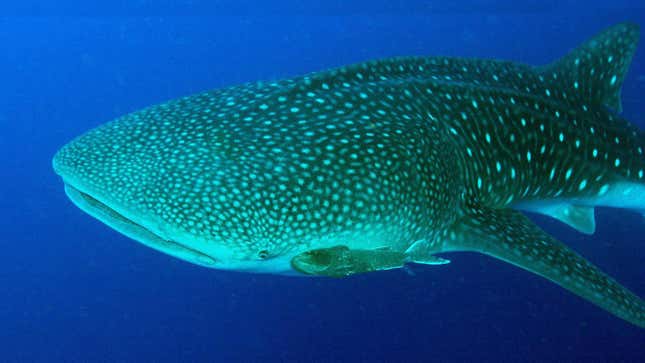
Marine biologists from Japan say whale sharks have eyeballs coated in tiny teeth, in a discovery unique to this hulking but gentle aquatic species.
Eye teeth are typically used to describe our upper canines, but new research published in PLOS One describes eye teeth of a literal sort.
Marine biologists from Japan’s Okinawa Churashima Research Center have found that whale sharks have eyes covered in dermal denticles, or modified teeth. These tiny structures represent a previously unknown form of eye protection, serving as a kind of armor to protect against the elements, according to the new research.

Whale sharks are the largest of the sharks, growing as long as 59 feet (18 meters). These behemoths are harmless to humans, feeding primarily on plankton and the occasional fish.
Whale sharks, unlike some other shark species, don’t have eyelids. Also, their tiny eyes are located at the corners of their square heads, exposing their peepers to potential damage. That’s where the protective eye denticles come in.

Sharks have dermal denticles elsewhere on their bodies. These marine animals don’t have scales like other fish, but they do have placoid scales, which are made of dermal denticles. These modified teeth, with their hard enamel, provide sharks with armor-like protection, but they also work to reduce friction in the water, helping sharks swim with speed and stealth.
For the new study, the researchers analyzed the eyes of both living and dead whale sharks from aquariums in Japan and the United States. It’s the first detailed investigation of whale shark eyes and possible protective mechanisms.

The researchers found a trove of dermal denticles distributed on the surface of their eyes, particularly around the iris. Nearly 3,000 eye denticles were found on a single eye ball. Calling them teeth is hardly an exaggeration; looking at the dermal denticles through a microscope, these structures actually look like teeth. Or as the researchers described them, they had a distinctly “oakleaf-like” appearance, in contrast to the three-pronged dermal denticles found in placoid scales.
The “covering of the eye surface with denticles in the whale shark is probably useful in reducing the risk of mechanical damage to the eye surface,” concluded the researchers in the study. Other sharks don’t appear to share this feature, making armored eyes unique to whale sharks, according to the study.
But that wasn’t the only protective mechanism detected in the eyes of whale sharks. As the new research shows, these gigantic fish also have an uncanny ability to pull their eyeballs into their eye sockets. The “retraction distance was calculated to be approximately half the diameter of the eye, which is comparable to those of other vertebrates that are known to have highly retractable eyes,” such as bottlenose dolphins, according to the paper. Together with the eye denticles, this retraction ability further serves to protect the vulnerable eyes of whale sharks.
Dermal denticles in sharks appear to be an adaptive trait, but teeth will sometimes show up in places where they shouldn’t, at least in humans. This is known as a teratoma, in which a tumor is found to contain different types of tissue, including teeth and hair. In teratomas, ectopic teeth, as they’re called, tend to appear in ovaries, and they can be safely removed during surgery.